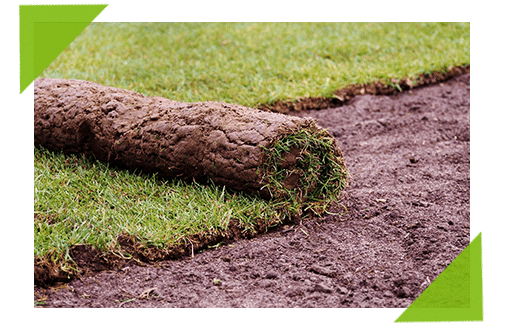How to Remove Sod
Sod is a popular option that many homeowners prefer when landscaping their homes. Removing sod from your yard can be a tedious task, depending on the amount of sod you have to remove. It’s important to remove the sod correctly, or you could end up with dead, patchy spots in your yard.
In this guide, we will outline the steps you need to take to remove sod from your property. We will also provide some tips on how to make the process easier. So if you’re looking to get rid of that unsightly sod, read on.

What to consider when removing sod
Type of sod
You will need to identify the type of sod you have before beginning the removal process. The most common type of sod is Bermuda grass, which is a warm-season grass. This type of grass is known for its durability and ability to withstand heavy traffic. It’s also relatively easy to remove.
The next most common type of sod is Kentucky bluegrass, which is a cool-season grass. This type of grass grows best in cooler climates and does not do well in hot, dry conditions. It’s also more difficult to remove than Bermuda grass.
Size of the area
The size of the area you need to remove sod from will also dictate how difficult the process will be. If you only need to remove a small patch of sod, the task will be much easier than if you have to remove an entire lawn.
What tools do I need?
Before you start digging up your lawn, you will want to make sure that you have all the right tools and materials on hand.
There are a few tools that you will need in order to remove sod correctly:
- A spade or shovel: This is necessary for digging up the sod.
- A wheelbarrow or tarp: This is needed for transporting the sod once it has been removed.
- A garden hose: This is used for watering the area after the sod has been removed.
Using a sod cutter
A sod cutter is more efficient than a shovel for removing large areas of grass. It has two blades that are spaced apart to make narrow strips (about 18 inches wide). A blade on each side of the machine cuts into the turf while small wheels on either side support it.
You walk behind and guide it with two handles attached to long handles and push it forward, cutting strips of turf in its path. The machine will cut the sod an inch or two below the root line, making it easy to remove.
Types of sod cutter
You can choose between motorized and manual sod cutters, but the manual ones are much easier for most people.
- Manual sod cutter: This type of cutter is pushed by hand and does not require any fuel. It’s lighter and cheaper than a motorized version, making it a good choice for small jobs.
- Motorized sod cutter: This type of cutter is powered by gas or electricity and can cover more ground in a shorter amount of time. However, it’s heavier and more expensive than a manual sod cutter. If you have a large area that needs to be removed or if you have many trees in your yard, then it may be worth renting an electric cutter from your home improvement store or local landscaping company.
It is recommended to use a sod cutter because they are lighter weight and they allow you to remove the sod without having to worry about cutting into the ground too deep.
How to remove sod
While a lush, green lawn is an ideal way to spruce up your outdoor space, sometimes you might want to remove sod in favor of a flower garden instead. Here are the steps on how to remove the sod.
Step 1: Remove plants and other lawn ornaments
Before you break out the tools, remove any plants and lawn ornaments from the area that needs work. This includes any edging around the perimeter of the area as well as any rocks, garden gnomes or other decorations.
Step 2: Watering
Water the sod thoroughly for one to two days before removal. This will make it easier to dig up and remove while avoiding damage or harm to the roots.
Step 3: Start work
You can rent a sod cutter or use a shovel to begin removing sod. The sod cutter is easier to use than a shovel; however, it can be difficult to control on slopes and hillsides, so if you have a lot of those in your yard, you might want to stick with a shovel instead. The choice is up to you.
Step 4: Cut the sod into shapes
Use a flat spade or shovel to cut the sod into squares or strips that are 2 feet wide. Use a sharp knife or sod cutter (available at some home improvement stores) if you don’t have a flat spade available.
Step 5: Dig
Dig under the sod with a flat spade, making sure you go about 6 inches deep. Do not put too much pressure on your spade as this can damage the root system that’s already in place.
Step 6: Remove the sod
After you’ve removed the first strip of sod, start removing sod from the second strip over and continue until you’ve removed all of the sod from your space. It’s best not to leave any of the old root system behind, so make sure that you’re able to dig up at least 6 inches of it before moving on to another strip.
Step 7: Smooth out rough spots and fill holes in the ground with soil or loam
Once all the sod has been removed, you might notice some bare spots or holes in the ground. You can fill these in with soil or loam and then smooth them out with a rake.
Step 8: Rake over the surface to smooth it out
After you’ve filled in any holes, rake over the entire surface to smooth it out. You can also use a lawn roller to help flatten the ground if needed.
Step 9: Add new sod or seed the area
The next step is to add new sod or seed the area with grass. If you’re adding new sod, make sure that you water it regularly so that it can take root and start growing. If you’re seeding the area, make sure to keep the seed moist by watering it regularly until the grass starts to grow.
Step 10: Water the topsoil lightly
Once you’ve added new sod or seed, water the topsoil lightly. You don’t want to saturate the ground, but you do want to make sure that the top layer of soil is moist.
Professional tips for removing sod effectively
Removing sod can be a tough and daunting task, but with the right tools and techniques, it can be done relatively easily. Here are some professional tips on how to remove sod effectively:
- Don’t try to remove sod in one big piece. Start by breaking it up into smaller sections with a spade or pitchfork.
- Wet the sod before you start trying to remove it. This will make it easier to lift and will also help to prevent the roots from drying out.
- Start at one end and work your way across. Use a back-and-forth motion as you go, being careful not to damage the underlying soil.
- As you remove the sod, pile it onto a tarp or something similar so that you can dispose of it later.
- Wear gloves to protect your hands from the sharp edges of the sod.
- Once you’ve removed all the sod, you’ll need to take care of the underlying soil. Be sure to loosen up the soil and remove any roots that might be left behind. You can then replant grass seed or lay down new sod.
You should use our sod calculator to figure out how much sod you need. Or we can help you find out how much does sod cost?
Frequently Asked Questions
When is the best time to remove sod?
The best time to remove sod is in the spring or fall when the weather is cool. Avoid removing sod in the summer when it’s hot and dry, as this will damage the underlying soil.
How deep do you dig to remove sod?
You only need to dig down about an inch or two to remove sod. Be careful not to dig too deep, as this can damage the roots of the grass.
What do you do with the removed sod?
The best way to dispose of removed sod is by composting it. This will help to add nutrients back into the soil. You can also throw it away, but be aware that it will take up a lot of space in your garbage can.
Can I use a power washer to remove sod?
No, you should avoid using a power washer as this can damage the underlying soil. Stick to manual tools like a spade or pitchfork when removing sod.
Conclusion
Now that you know how to remove sod, you can tackle this project with confidence. Be sure to follow all the steps outlined in this guide and you’ll have no problem removing sod from your yard. With a little elbow grease, you can have a beautiful lawn in no time.







